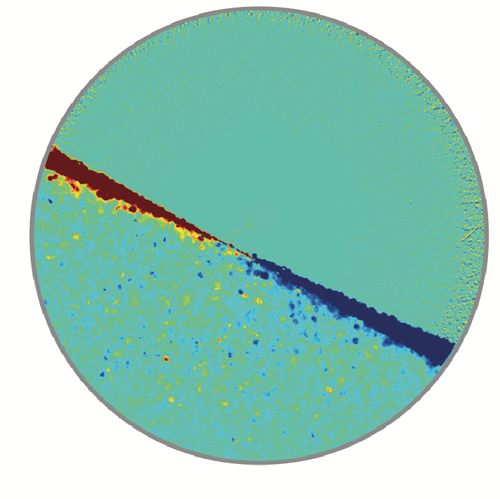Friction, Not Inertia, Controls Avalanches
A classic type of experiment on granular materials such as beads, sand, or sugar involves observing how the material moves inside a slowly turning drum with a transparent window, somewhat like a clothes drier. In a new investigation using this technique, researchers controlled the amount of friction between tiny silica beads immersed in a liquid. Contrary to some earlier theories, they found that friction was the crucial factor determining when the mixture, as it was tilted at an increasing angle, transitioned from a solid-like pile to a fluid-like flow. The findings suggest that the behavior of dry granule heaps and those immersed in liquid have much in common and may lead to new insights into phenomena ranging from undersea landslides that can cause tsunamis to the flow of industrial mixtures through pipes.
A pile of dry material such as sand on a board suddenly begins to flow when the board is tilted to a critical angle. The avalanche continues until the surface slope falls to a point at which the material is immobilized by friction and the interlocking of grains.
Starting in the early 2000s, theoretical studies and experiments convinced many granular materials experts that the inertia of the particles was the main factor governing avalanches. Once the particles start to move, inertia keeps them going until they fall together into a new pile with a lower surface angle. In a 2003 experiment [1], investigators studied flows of beads immersed in liquids with different viscosities. A viscous liquid reduces the effective inertia of the beads because it suppresses any bead motion through it. The experiment showed that the greater the viscosity of the liquid, the smaller the difference between the angles at which avalanches start and stop, supporting the idea that inertia is the controlling factor.
Yoël Forterre of Aix Marseille University, France, and his colleagues recently made a surprising discovery while studying how rapid stirring of water slurries of certain solids makes them abruptly stiffen—a phenomenon called shear thickening [2]. They found that a suspension of 24-micrometer-diameter silica beads in water or water plus glycerol displayed avalanche behavior, even though the beads in the suspension had even lower effective inertia than in the 2003 experiments.
This result cast doubt on inertia as the key to avalanching, so the researchers investigated whether interparticle friction might be more important than inertia. They used a technique for controlling friction that they had previously devised. Because silica beads in water spontaneously accumulate negative surface charges, electrostatic repulsion pushes the beads apart, eliminating friction. But adding sodium chloride to the solution reawakens friction to a controllable degree because positive charges from the salt quell the repulsion.
The researchers observed the frictionless state by half-filling a 12-millimeter-diameter drum with the tiny beads, topping it off with salt-free water, and slowly rotating the drum. Without friction, only geometrical interlocking of the beads held them in place. When the mixture’s surface reached a shallow angle that overcame the interlocking—6°—the beads began flowing smoothly and steadily, rather than exhibiting a sudden avalanche. The slow and continuous flow of beads maintained the surface at a constant angle of 6°. But when adding salt to turn the friction back on, the researchers saw the start-and-stop flow of avalanches, which became more pronounced at higher salt concentrations.
Friction was leading to avalanching even though the beads were effectively inertia-free. This behavior “was in contradiction with existing models,” says Forterre. “These experiments are the first to show that friction is needed for avalanching, even though inertia is not.”
For many years, scientists thought that the fluid in granular suspensions would generally keep the particles apart, so that their flow behavior would be fundamentally different from that of dry grains subject to interparticle friction, says Heinrich Jaeger of the University of Chicago. But in the past decade, he adds, experiments and analyses have revealed many similarities between the two systems. The new results reinforce this change in thinking by demonstrating that there is, in the suspension of silica beads, “a big difference, a beautiful difference, in behavior, depending on whether the friction is engaged or not,” Jaeger says. Michael Clare of the National Oceanography Centre in Southampton, UK, says the study’s findings are important for understanding small landslides of granular sediments that often disrupt seabeds and cause powerful, local tsunamis.
This research is published in Physical Review X.
Correction (19 August 2019): The text has been corrected to properly describe the friction-free portion of the experiments, which exhibit a small critical angle but no avalanching.
–Peter Weiss
Peter Weiss is a freelance science reporter and editor in Washington, D. C.
References
- S. C. du Pont, P. Gondret, B. Perrin, and M. Rabaud, “Granular avalanches in fluids,” Phys. Rev. Lett. 90, 044301 (2003).
- C. Clavaud, A. Bérut, B. Metzger, and Y. Forterre, “Revealing the frictional transition in shear-thickening suspensions,” Proc. Natl. Acad. Sci. 114, 5147 (2017).





